On 1 March 2024, the Netherlands’ State Secretary for Defence, Christophe van der Maat, outlined multi-billion Euro plans to procure a new maritime air and missile defence (IAMD) capability to replace the Royal Netherlands Navy’s (RNLN’s) current four De Zeven Provinciën class air defence and command frigates (‘luchtverdedigings en commandofregatten’ or LCF) from the mid-2030s.
Detailing the top-level requirements to the House of Representatives in a so-called ‘A-letter’, van der Maat said that the new capability would involve the acquisition of an indigenously-developed surface combatant and above-water combat system, together with a yet to be decided air defence missile system sourced internationally. The Ministry of Defence’s Materiel and IT Command (COMMIT) – the new name given to the Defence Materiel Organisation (DMO) in April 2023 – intends to forge a partnering arrangement with local industry at an early stage in order that the two main suppliers – Damen Naval for the ship platform and Thales Netherland for the radar/fire control system – can contribute fully to the planning and development process.

Credit: US Navy
In the meantime the existing LCFs – HNLMS De Zeven Provinciën, Tromp, De Ruyter and Evertsen – are required to stay in service for a decade or more while their replacements take shape. To this end, significant investment has been made to extend all four frigates in service beyond their original design life, with the last two ships now likely to serve through to 2036-2037. And having already received a number of substantive upgrades, including a new extended range radar, the De Zeven Provinciën class is set to receive further improvements. These include a replacement medium-calibre gun and new anti-air, anti-surface and strike weapon systems during the course of this decade.
Design and development
The De Zeven Provinciën class frigate design emerged in the wake of the collapse of the NFR90 frigate programme. What was then Royal Schelde – now Damen Naval – was contracted in 1993 to support project definition for a national frigate platform. Subsequently, in June 1995, the company was awarded a build contract for two frigates. This was later increased to four ships.
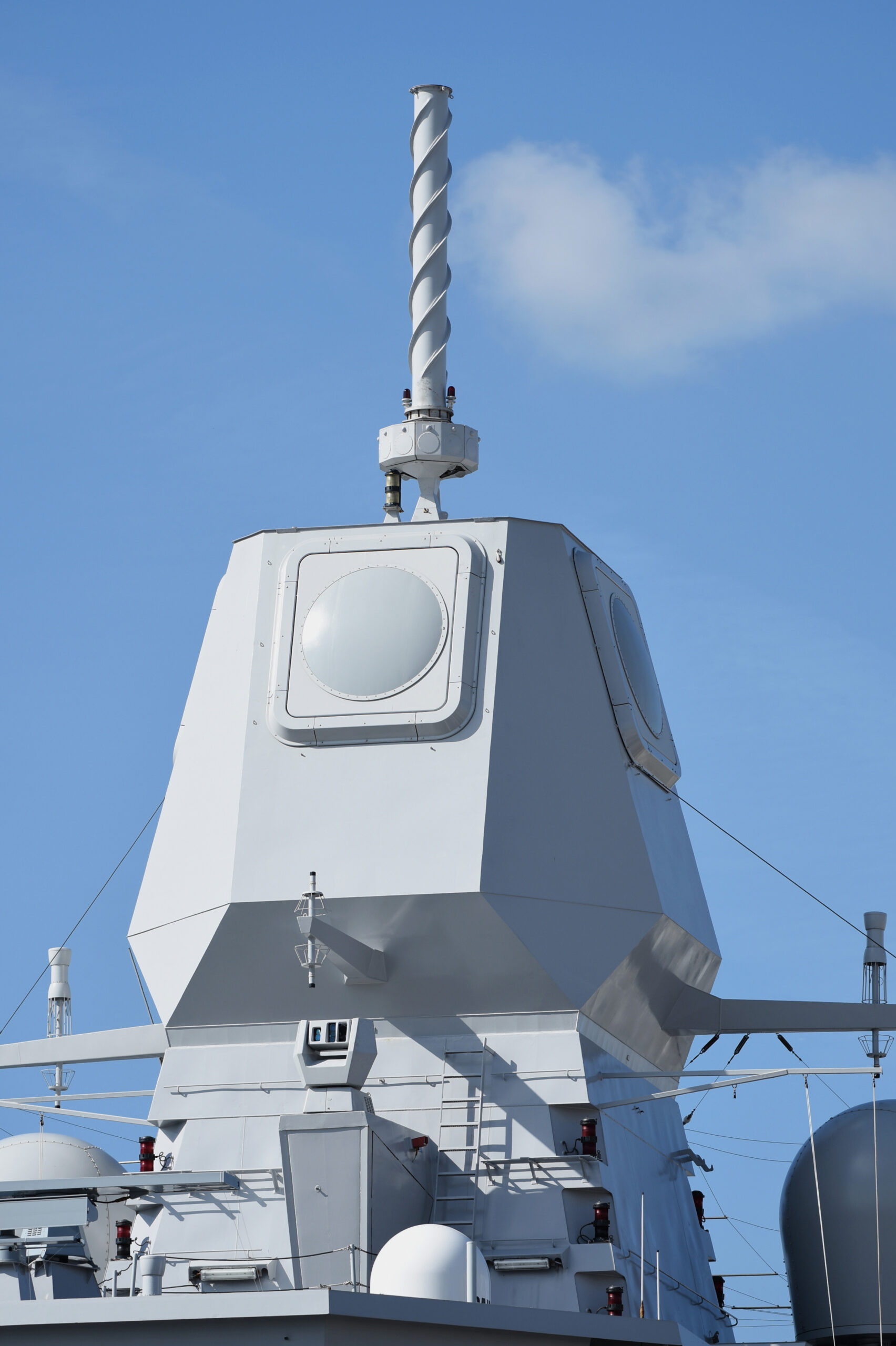
Credit: Richard Scott
As conceived, the LCFs were primarily roled for fighter control and medium-range air defence. In addition, they were equipped with appropriate facilities to host and support an embarked flag staff. A strict ‘design-to-cost’ philosophy was adopted in order to drive cost out of design, engineering, and manufacturing and so bring the programme within its approved budget ceiling. This approach – based on the development of functional requirements rather than prescribed specifications – drove a number of cost/capability trade-offs, and a decision to apply military standards only where strictly necessary. As a result, commercial off-the-shelf equipment could be adopted in many areas of the ship provided it met appropriate technical standards, Furthermore, the application of rigorous military standards for shock, noise, electromagnetic compatibility, and redundancy was limited to those critical equipments/areas required to support the combat system and propulsion.
Another important consideration for the LCF design was crew size: whereas the earlier Tromp class air defence frigates had a complement of over 300, the De Zeven Provinciën class ships operate with a standard crew of 172, increasing to 183 with the embarked helicopter flight. This reduction was achieved through widespread systems integration, increased automation, and detailed consideration of human factors in both operational spaces and crew living areas.
The combat system delivered for the LCF programme hinged on two component parts. One was the national ‘Guardion’ combat management system (CMS). This was developed and integrated by the RNLN’s in-house Centre for the Automation of Mission-critical Systems; now vested in the Maritime IT department within COMMIT’s ‘Joint Informatievoorziening Commando’ [JIVC] information technology organisation. The other was an anti-air warfare system (AAWS) developed by a Hollandse Signaalapparaten (now Thales Nederland) led consortium under the Trilateral Frigate Cooperation with Germany and Canada.
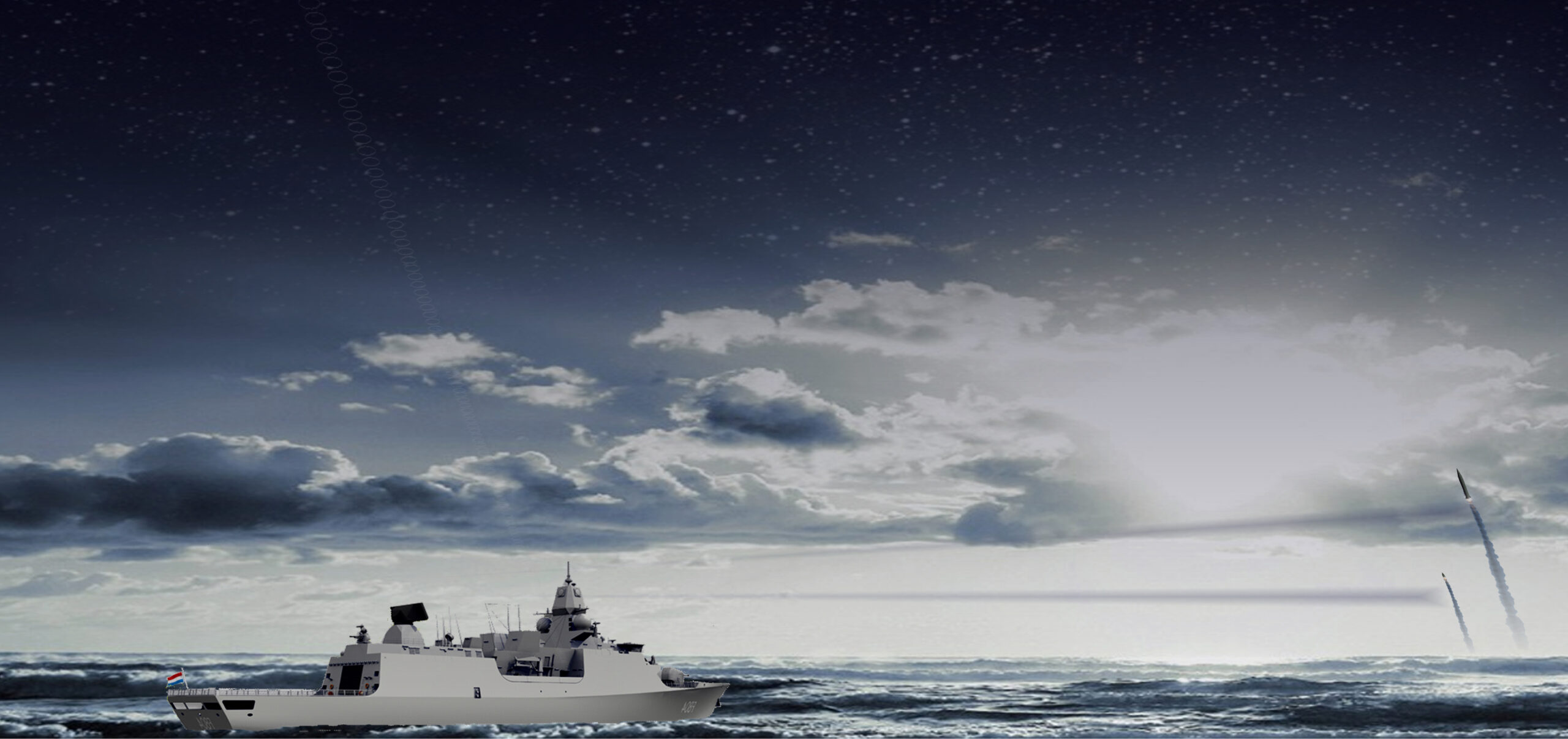
Credit: Thales
The AAWS married a fire control cluster with a sensor suite comprising the APAR X-band multifunction radar, the SMART-L L-band volume search radar, and the SIRIUS dual-band infrared search and track system. It was noteworthy in that, for the first time in a naval application, it implemented the interrupted continuous wave illumination (ICWI) technique for missile guidance: ICWI uses mid-course guidance and sampled data homing to enable a single fire control radar (in this case, the Block 1 version of APAR) to support multiple simultaneous engagements using semi-active radar homing missiles – either the Evolved SeaSparrow Missile (ESSM) Block 1 (for self-defence) or the Standard Missile-2 (SM-2) Block IIIA (for area defence).
Commissioned into the RNLN between April 2002 and June 2005, the four LCFs were declared fully operational in 2006. This followed extensive testing to demonstrate AAWS functionality and performance, as well as to validate the ICWI missile guidance technique fully.

Credits: COMMIT
Fleet ‘spine’
Two decades after entering service, the De Zeven Provinciën class frigates remain the warfighting ‘spine’ of the RNLN surface fleet, and continue to routinely serve in national, multinational, NATO and EU operations: as a case in point, Tromp in late March 2024 commenced tasking in the Red Sea in support of Operation ‘Prosperity Guardian’ (the US-led multinational effort to protect shipping from Houthi missile and drone attacks).

In recent years, the four LCFs have been cycled through an upkeep and conservation programme, codified as the Instandhoudingsprogramma LCF (IP-LCF). This has embodied a broad package of improvements intended to address materiel obsolescence, maintain seaworthiness, and ensure compliance with prevailing safety and environmental legislation. Beginning implementation in 2018 with the refit of De Zeven Provinciën at the ‘Directie Materiële Instandhouding’ (DMI) facility inside Den Helder naval base, the IP-LCF covers 41 discrete sub-projects extending across all areas of the ship. In its totality, the work encompasses the replacement, renewal, or modification of over 1,000 individual systems, equipment, and peripherals, and the laying of approximately 30 km of new cabling.
These discrete addition and alteration packages can be split into two categories. The first comprises those sub-projects focused on maintaining compliance with the latest standards in areas such as ammunition safety, environmental compliance, occupational health and safety, and safe navigation. Examples include a modernised bridge, and a new ballast water treatment system. A second category of sub-projects has been addressing materiel and/or functional obsolescence onboard, most notably the CMS and the integrated monitoring and control system (IMCS). In the former case, the Guardion CMS has been upgraded with new server hardware, plus new RH Marine workstations and Baytek large-screen displays in the command centre. With regard to the IMCS, RH Marine has upgraded the workstations inside the technical centre, introduced new software-based ship control functionality, and developed an interactive electronic state board to support damage control/firefighting co-ordination.
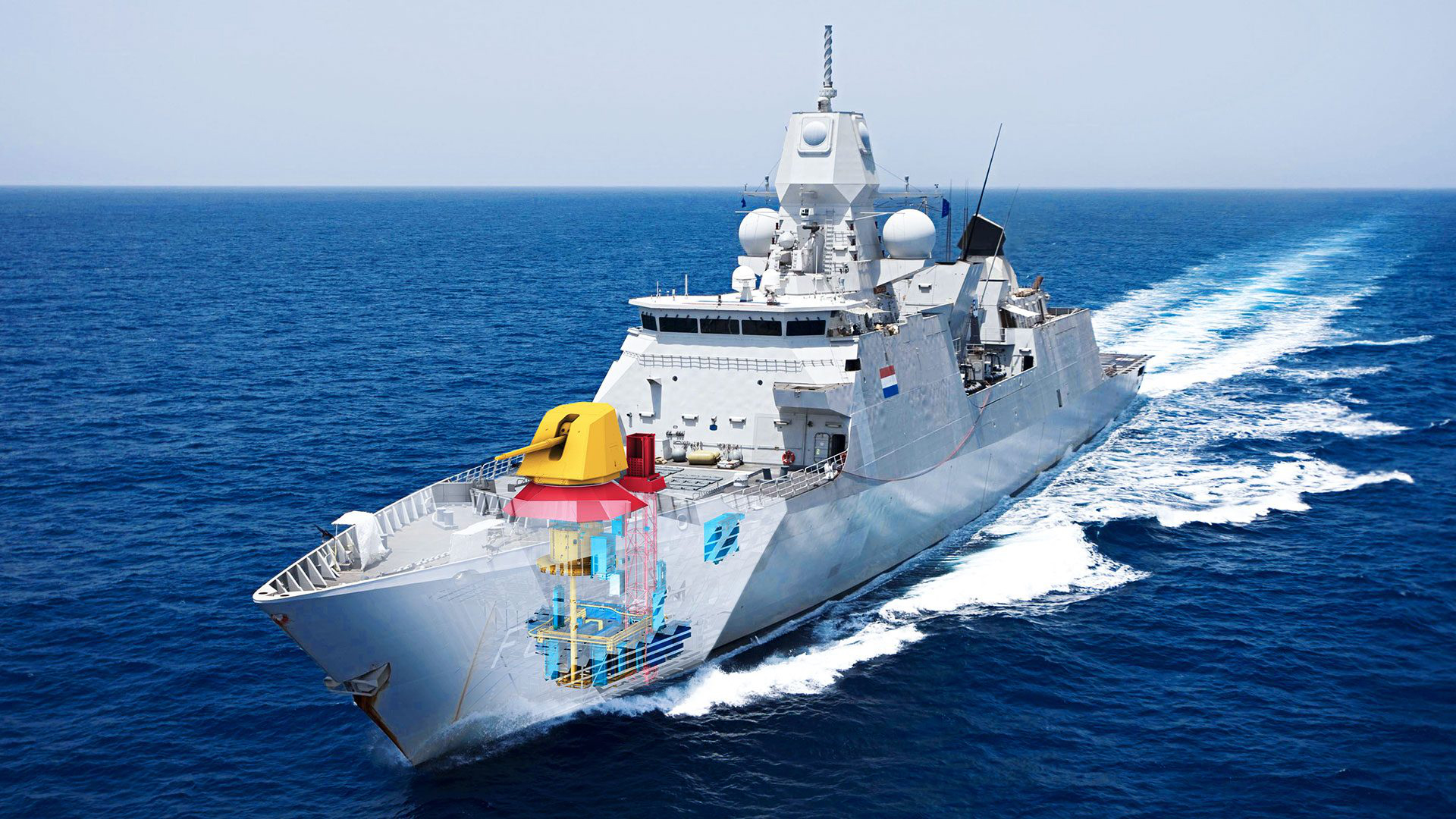
Credit: Nevesbu
De Zeven Provinciën, Tromp and De Ruyter have all now completed their IP-LCF embodiments. Evertsen is currently completing its IP-LCF implementation at DMI as part of an extended refit, due to complete in early 2025, which also includes the installation of a new main gun.
Owing to delays in the LCF replacement programme, the De Zeven Provinciën class ships will now remain in service for some time longer than had originally planned. To ensure that the frigates can continue to operate safely, and remain operationally relevant, a new budget line – ‘Langer doorvaren LCF: Materiële zeewaardigheid’ (translated to Longer sailing LCF: Material seaworthiness) – was established by COMMIT in 2023. This funds a series of further measures to address diminishing sources of supply and obsolescence in both hardware and software. Examples include general ship systems such as cooling, heating and fire alarms; minor electronic systems; and networks and computer systems. The project also includes the adaptation of trainers and simulators; education and training resources; documentation and manuals; equipment management; and logistics support/sparing. In addition, the software associated with integration of the ESSM Block 1 missile is approaching obsolescence.
Modifications associated with this budget line will be embodied during overhauls in the period 2024-2029. A software modification will be introduced to enable the two oldest ships – De Zeven Provinciën and Tromp – to continue to use ESSM Block 1 through to their end of life. The two youngest frigates – De Ruyter and Evertsen – are to receive a radar system upgrade allowing them to integrate the ESSM Block 2 missile. De Ruyter and Evertsen will also receive other hard-kill and soft-kill improvements given their longer remaining service life.
MBMD upgrade
A major sensor/command system upgrade conferring a Maritime Ballistic Missile Defence (MBMD) capability has been rolled out in parallel with the IP-LCF programme. This enables the De Zeven Provinciën class ships to detect and track ballistic missile threats at ranges out to 2,000 km, as well as to provide fire-control quality cues to co-operating ‘shooters’.Key to the MBMD upgrade is the introduction of the Thales Nederland SMART-L MM/N extended long-range L-band radar. An active electronically scanned array radar combining dual-axis multibeam processing with a patented extended long-range waveform proven in live at-sea testing, SMART-L MM/N is designed to operate in a number of rotating and staring modes to support volume air surveillance and/or ballistic missile long-range search and track. The system has a maximum instrumented range of 2,000 km in staring mode.
Alongside SMART-L MM/N, the MBMD upgrade has additionally required the integration of a Tecnobit LINPRO multilink processor (enabled to exchange data via the Link 16 JREAP-C beyond-line-of-sight message protocol) and modifications to the Guardion CMS. In the latter case, the Maritime IT department within JIVC worked to develop the interface for the new radar, and also to embed a BMD planning tool.
De Zeven Provinciën proved this new MBMD capability in two live-fire events conducted as part of the multinational ‘At Sea Demonstration/Formidable Shield 21′ (ASD/FS-21) exercise in the North Atlantic in May 2021. In the first case, the ship demonstrated its integrated air- and missile-defence capability by engaging two low-altitude air-breathing threats while simultaneously tracking a ballistic missile target; in the second, De Zeven Provinciën provided tracking data enabling a US-guided missile destroyer to launch an SM-3 Block IA exo-atmospheric interceptor against a ballistic missile target still outside the range envelope of its own radar (‘launch on remote’).
De Zeven Provinciën, Tromp and De Ruyter have all completed the MBMD upgrade, with Evertsen receiving the capability during its current refit. The expectation is that, from 2025, the LCF frigates and their MBMD capability will be offered as a Voluntary National Contribution to the NATO Ballistic Missile Defence programme. It is intended that the SMART-L MM/N radar will be cross-decked to the LCF replacements as the De Zeven Provinciën class ships leave service.
Replacement gun
The next major upgrade – now underway on Evertsen – is the introduction of the Leonardo 127/64 LW Vulcano medium calibre gun and associated ammunition handling system. The acquisition of a new gun system reflects the obsolescence of the original 127/54 Compact gun systems, which were acquired second-hand from Canada and date from the late 1960s. Although refurbished and upgraded around the turn of the century, these mountings are now well beyond their 30-year design life and proving increasingly unreliable and difficult to support. Also, the existing ammunition handling system is not compliant with modern working/safety practices.
In 2018 the then DMO established the 127 mm replacement programme to deliver a new medium calibre gun system to the De Zeven Provinciën class frigates together with a semi-automatic ammunition handling system. This programme also includes the adaptation of the magazine, and associated integrated logistic support. In April 2020 it was announced that Leonardo had been contracted to supply of its 127/64 LW Vulcano gun, which will confer the ability to fire extended-range, precision-guided Vulcano munitions as well as conventional ammunition. Alongside the gun system itself, the company’s scope of supply also includes a new automated ammunition handling system and a naval fire support mission planning tool.
It is recognised that the installation and integration of the 127/64 LW Vulcano gun and its ammunition handling system represent a complex engineering task requiring a major redesign of the spaces in the forward section of the hull. The maritime technology/naval design house Nevesbu has been contracted by both Leonardo and COMMIT to develop the integration and associated design change package for the mounting installation, the revised ammunition compartment, and the new automated handling system. As a subcontractor to Leonardo, Nevesbu has been focused on the system design task; while for COMMIT, Nevesbu has undertaken spatial and functional integration of the new equipment in compliance with shock/hazard standards and prevailing health and safety legislation.
Another requirement is to extend the ship’s electrical system (the 127/64 LW Vulcano gun using electric rather than hydraulic drive). Thales Nederland is taking responsibility for integration of the new gun with the CMS.
As previously mentioned, Evertsen is receiving the gun upgrade during its current refit in Den Helder. While lessons learnt from this first installation are expected to reduce the time required for subsequent retrofits, the complex and intrusive nature of the medium-calibre gun retrofit means that it can only be performed during deep refit. This means that De Ruyter, as the final ship to receive the 127/64 LW Vulcano, will not be upgraded until 2029. The intention is to cross-deck all four 127/64 LW Vulcano mountings to the LCF replacements as the De Zeven Provinciën class ships are phased out of service.
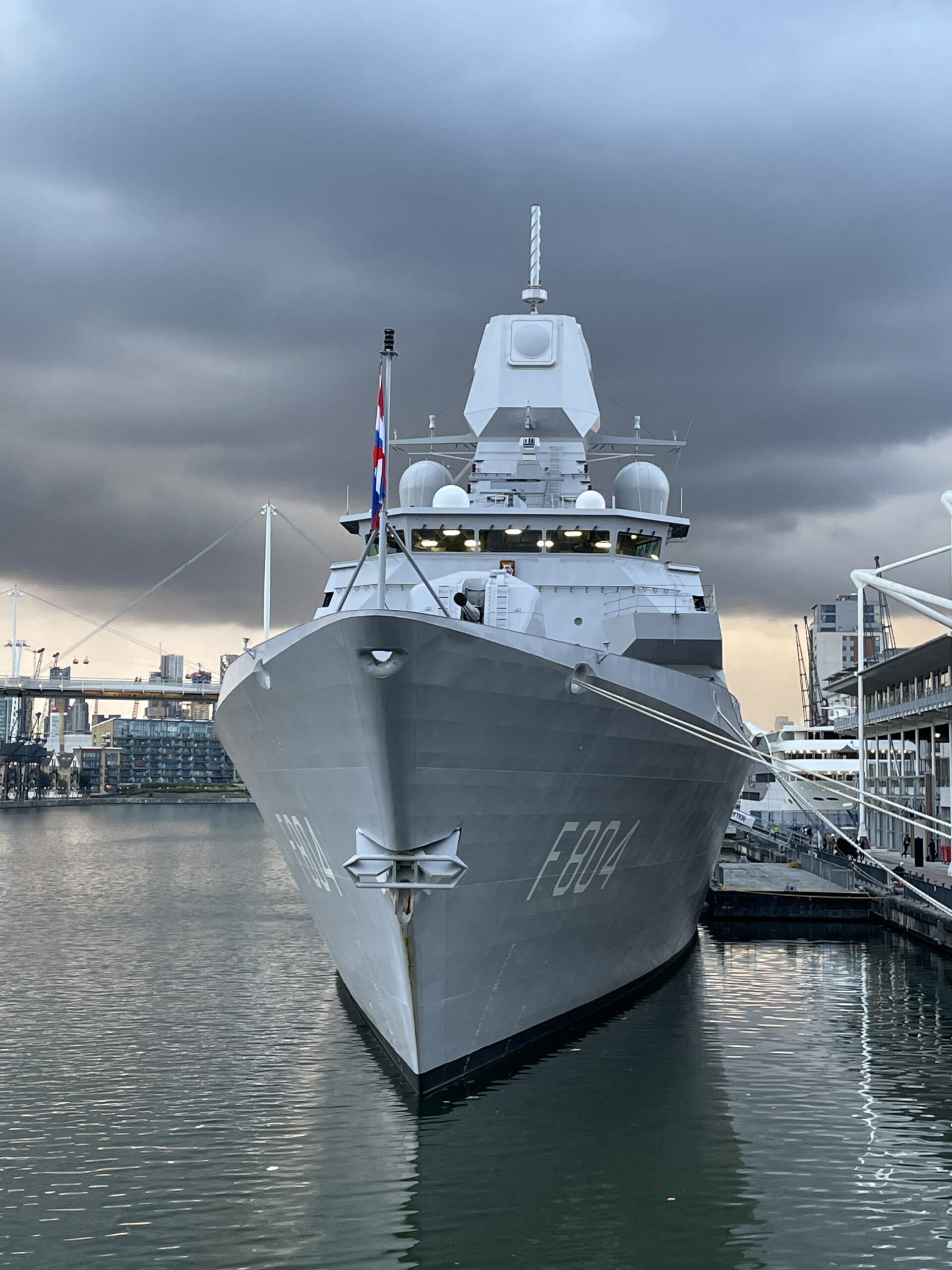
Credit: Richard Scott
Anti-ship and strike missiles
Another investment designed to maintain the operational relevance of the LCF frigates is the procurement of a replacement maritime surface-to-surface missile to succeed the current RGM-84L Harpoon Block II anti-ship missile. Kongsberg Defence and Aerospace was in late 2022 contracted by the DMO to supply its Naval Strike Missile (NSM) following a competitive evaluation, including technical assessments performed by the TNO research organisation. NSM deliveries are planned to begin before the end of 2025.
In April last year, following Russia’s military offensive against Ukraine, the Dutch government announced plans to proceed with the acquisition of a maritime strike capability – in the shape of the US-built Tomahawk Block V cruise missile – for both surface ship and submarines. This will make the RNLN only the second European naval service to introduce Tomahawk into service. The four LCF frigates are all planned to receive Tomahawk, which can be accommodated within the ships’ existing 40-cell MK 41 strike length vertical launch system. A proof-of-concept firing from De Ruyter is planned in the third quarter of 2024 on the US Navy’s Point Mugu sea range off California.
Integration of Tomahawk into the LCF frigates will require the installation of additional weapon control equipment and associated software. Current planning assumptions – subject to final confirmation of the Foreign Military Sales (FMS) case – foresee the first full Tomahawk implementation starting in 2026 as part of a scheduled maintenance period. This would see the first LCF become operational with the Tomahawk Block V missile in 2027.
The introduction of a new lightweight torpedo is also planned for the De Zeven Provinciën class. In this case, the US Mk 54 weapon will be introduced as a replacement for the legacy Mk 46 Mod 5 lightweight torpedo. The Mk 54 will be carried by embarked NH90 helicopters, and also loaded in ship-mounted Mk 32 Mod 9 twin torpedo tubes.
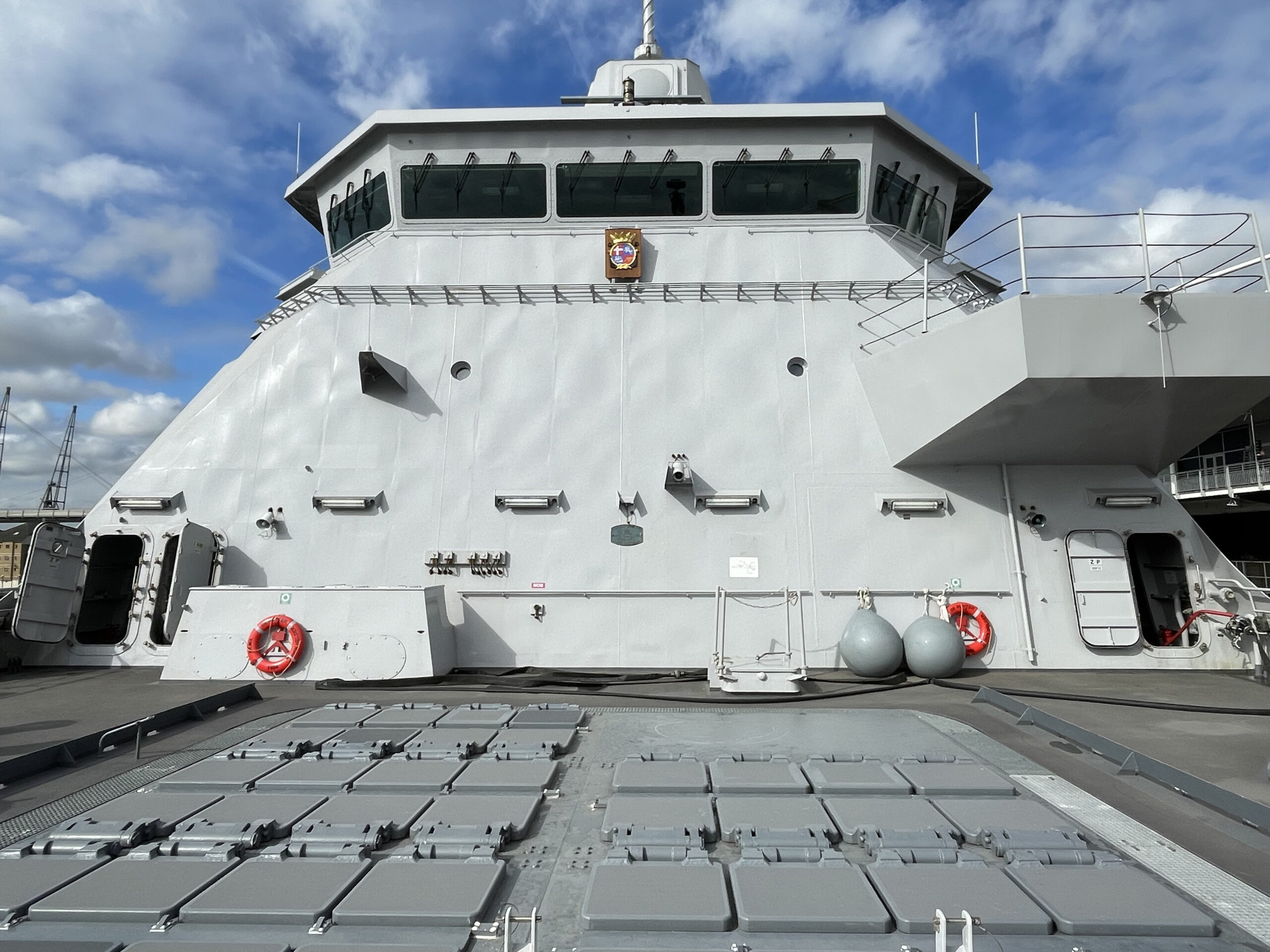
Credit: Richard Scott
Electronic warfare
The LCF ships have been equipped from build with the Thales UK (formerly Racal) Sabre electronic warfare (EW) system. As originally installed, Sabre combined radar band electronic support measures (ESM) and active electronic countermeasures (ECM) subsystems. The active ECM component – a multi-mode self-protection jammer – has now been retired from service.
Reflecting the more demanding threat environment, the ‘Langer doorvaren LCF: Elektronische oorlogvoering’ (Longer sailing LCF: Electronic warfare) project has been established to procure a modernised EW capability. In the first instance, this is intended to deliver a more modern ESM able to achieve greater detection range (for improved situational awareness and earlier threat warning) and improved signals measurement/analysis (to provide unambiguous emitter identification). In addition, De Ruyter and Evertsen – as the two frigates with the longest remaining lifespans – are also planned to receive a modern ECM system to disrupt threat radar seekers. The planned EW improvements are expected to be embodied during refit periods through to 2029. The EW upgrade also demands the purchase of a new trainer/simulator to fully reflect the new equipment installation on board.
Anti-air missiles
Work is underway to recapitalise the RNLN’s inventory of self-defence and area defence anti-air guided weapons. In the first case, the Netherlands is a partner in the US-led development and manufacture of the ESSM Block 2 missile, which replaces the earlier Block 1 guidance section with a dual mode active/semi-active X-band radar seeker in order to counter the latest generation of fast, low-altitude, and highly manoeuvrable anti-ship cruise missile threats. A new warhead is also being introduced.
Guidance and control of ESSM Block 2 will be enabled by the latest APAR Block 2 radar. APAR Block 2 features an all-new digital radar front end (embodying a new gallium nitride transmit/receive module and digital beam forming) and a scalable, reconfigurable architecture to facilitate future upgrades. It also introduces the Joint Universal Weapon Link datalink to provide guidance support for ESSM Block 2. Only De Ruyter and Evertsen will receive the APAR Block 2 retrofit, which is planned to take place in the late 2020s. The intention is that, when De Ruyter and Evertsen retire, both APAR Block 2 radars will be transferred to two of the four new-build LCFs (the other two ships receiving new systems at build).
De Ruyter and Evertsen are also in line to receive an upgrade to their inner-layer hard-kill defences. In this case, the Raytheon/RAM System GmbH RIM-116 Rolling Airframe Missile system is to replace the current Thales Goalkeeper 30 mm close-in weapon system.
As regards area air defence, the Netherlands has signed FMS agreements with the US Navy for additional buys of the SM-2 Block IIIA missile to sustain its war stock inventory and meet peacetime firing requirements until 2030. This offtake – being delivered under FY 2019 and FY 2021 production – was negotiated as part of a larger FMS buy with other international SM-2 customers.
Author: Richard Scott is a well-known author and commentator on naval operations and technology.




